Which of the following statements about the QoS treatment of self-generated traffic in the Nokia 7750 SR is FALSE?
What is the 6-bit binary representation of DSCP value AF21?
According to the SAP-ingress QoS policy shown, which of the following statements about processing of the packets by policers 3 and 4 is TRUE?
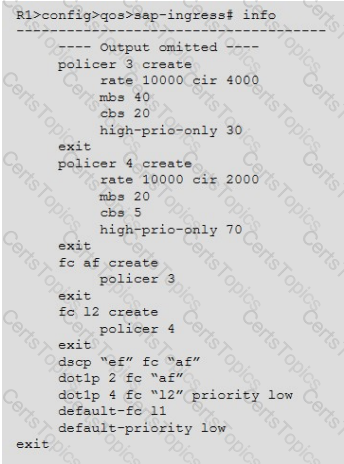
Which of the following QoS functions does the slope-policy perform?
Which of the following statements about port schedulers is TRUE?
Click the exhibit button below. Given that the slope-policy (below) has been enabled and applied on a network port, which of the following statements are TRUE? (Choose three)
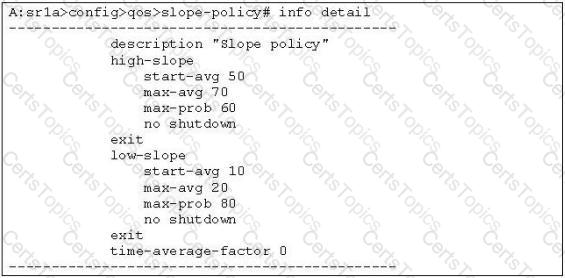
On the Nokia 7750 SR, what is the maximum number of ingress queues that a single network queue policy can support in a VPLS?
Which of the following statements about buffer admission control techniques is FALSE?
Which of the following entities can scheduler policies be applied to? (Choose two)
Which of the following statements about a queue’s rate parameters is FALSE?
Click the exhibit button below. Given the scheduler-policy (below), which of the following can be done to guarantee that the best-effort traffic receives its configured CIR value?
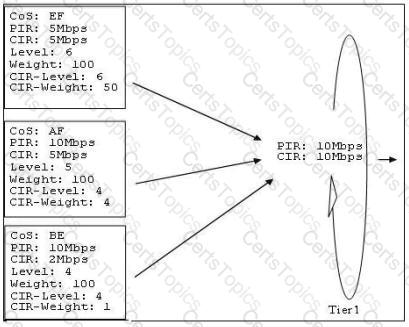
Which action should be taken to ensure that packets do not use the shared buffer space when put into a queue?
Which of the following statements about the default scheduler in the Nokia 7750 SR is FALSE?
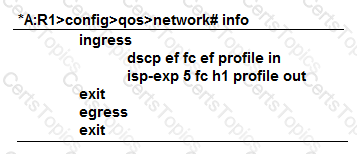
In the image shown above, the network QoS policy is applied properly to a Nokia 7750 SR. An MPLS packet with dot1p=1, EXP=4, and DSCP=AF is received. Which forwarding class and profile is assigned to this packet?
According to the SAP-ingress QoS policy shown, which packets have a higher priority to enter queue 2?
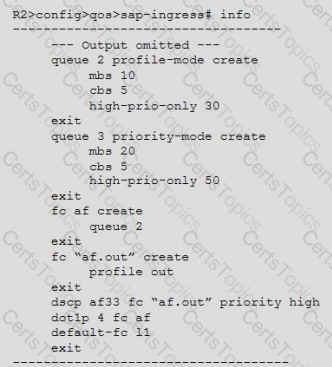
On an Nokia IOM 3, how is buffer memory allocated per forwarding complex?
Which of the following statements about the consequences of congestion is TRUE?
On the Nokia 7750 SR, what is a slope policy used for?
Which of the following statements about burst-limit of a queue is FALSE?
Forwarding subclasses are only relevant to, and are therefore applied within the context of, a _____________policy.
Which of the following statements about the bandwidth allocation criteria used by an egress port scheduler is TRUE?
Which of the following modules has 768 MB of buffer memory that dynamically allocates between its two MDAs?
Which of the following statements BEST defines policing?
Which of the following BEST describes a SAP when regarding QoS?
Which of the following statements are TRUE regarding the remarking of packets arriving on the network interface whose ToS-marking-state is set to trusted and remarking enabled on network egress? (Choose two)
Click the exhibit button below. Each router is interconnected by a single GigE link, as shown in the diagram below.
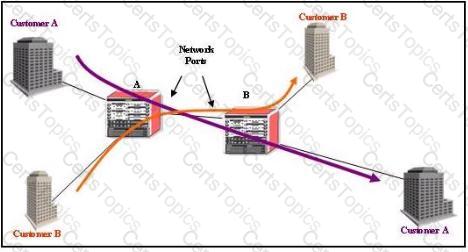
Note: The arrows show the direction of traffic flow.
Traffic from Customer A and Customer B that is classified to the same forwarding class is queued together at the ingress of Router B.
A physical port has three associated buffer pools. Which of the following buffer pool combinations is associated to a physical port?
Which of the following rate-limiting approaches are used on the Nokia 7750 SR? (Choose two)
When deploying a Nokia MPLS network with QoS, how are the EXP bits set?
What can be learned from the output of the command “show pools 1/2/2 network-egress” on the GigE port?
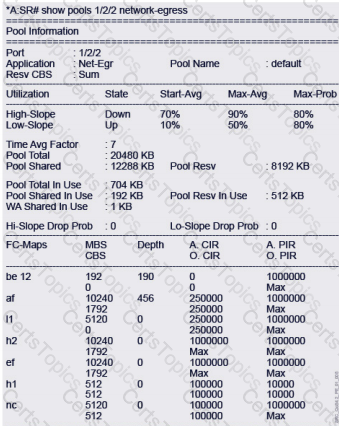
On a Nokia IOM 3, how is buffer memory allocated per forwarding complex?
Which of the following statements about CIR of a queue is TRUE?
Which of the following statements is considered best practice when changing a network policy that has been associated with an interface?
If two queues complete for bandwidth in a hierarchical scheduler environment, which parameter is used by their parent scheduler to determine the priority with which each queue can use bandwidth above its committed rate?